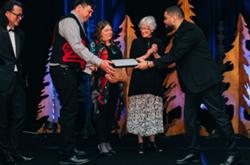Compiled by veteran medical journalist Brian Owens, this roundup of some of the newest science on the COVID-19 pandemic, straight from the scientific journals, is presented by Hakai Magazine in partnership with The Tyee.
Who should get the vaccine first in Canada?
The pharmaceutical company Pfizer announced promising preliminary data about its COVID-19 vaccine this week, but when and if the vaccine becomes available, initial supplies will be limited. So, governments will need to make careful decisions about who gets the vaccine first to maximize the impact of a limited resource.
Canada’s National Advisory Committee on Immunization recommends vaccinating key populations first. These groups include those at high risk of severe illness and death from COVID-19 due to age and other high-risk conditions; those most likely to transmit COVID-19 to people at high risk; health-care workers essential to maintaining the COVID-19 response; other essential workers vital to the functioning of society; and those whose living or working conditions put them at elevated risk of infection, where infection could have disproportionate consequences such as in Indigenous communities.
Canadian Medical Association Journal, Nov. 3, 2020
A wide variety of immune responses in different patients
How a person’s immune system responds to COVID-19 is a pressing question for the development and use of vaccines. A group of new studies has found that there can be a great deal of variation between different groups of people.
One study found that when most people recover from the disease, the number of antibodies against the virus they produce declines, while a subset of patients continues producing antibodies for several months following infection. These patients also show symptoms for less time, suggesting that people who recover quickly may be mounting a more effective and durable immune response.
Another study found that children produce different types and amounts of antibodies than adults, and that children can more easily clear the virus from their system with a less robust immune response. A third study even found pre-existing immunity to COVID-19 in a small group of people, likely driven by antibodies related to a previous infection with a common cold coronavirus. These cross-reacting antibodies were relatively more common in children and adolescents.
Nature Immunology, Nov. 5, 2020
Big delayed outbreaks of disease are possible after COVID-19
Non-pharmaceutical interventions, such as mask wearing and physical distancing, have helped curb the spread of not just COVID-19, but other respiratory diseases such as the flu and respiratory syncytial virus, the most common cause of bronchitis. But these reductions may only postpone future outbreaks of these diseases, and may increase our susceptibility to them, because the interventions prevent the low levels of transmission that maintain population level immunity. The result could be that, when COVID-19 interventions end, we are faced with large outbreaks of these other diseases.
Proceedings of the National Academy of Sciences, Nov. 9, 2020
Masks don’t hinder breathing during exercise
Wearing a surgical or homemade cloth mask during intense exercise does not have a detrimental effect on performance, and only minimal effects on blood and muscle oxygen levels in healthy people, according to a study by researchers at the University of Saskatchewan. The researchers say masks make exercise safer, because vigorous exercise leads to heavy breathing, which can propel respiratory droplets further than normal breathing.
International Journal of Environmental Research and Public Health, Nov. 3, 2020
One fifth of New Yorkers have been infected
About 20 per cent of the population of New York City — more than 1.7 million people — have already been infected with COVID-19, according to a study of blood samples taken between February and July. The study also found that the virus was present in the city long before the first case was confirmed on March 1, and that the infection fatality rate was around one per cent — 10 times deadlier than the flu.
Crowded nursing homes had higher death rates in Ontario
Infection and death rates in crowded Ontario nursing homes were more than double those in homes that were less crowded. Homes with an average of fewer than two residents per bedroom and bathroom had an infection rate of 4.5 per cent and a death rate of 1.3 per cent, while those with an average of more than two had an infection rate of 9.7 per cent and a death rate of 2.7 per cent.
JAMA Internal Medicine, Nov. 9, 2020
Abnormal cells triggered by COVID-19 may explain ‘long COVID'
Long-lasting lung damage caused by COVID-19 may help explain why some patients continue to experience symptoms like fatigue and shortness of breath for months after they have otherwise recovered from the disease.
A study of the lungs of people who died of COVID-19 found extensive damage, with widespread blood clotting in the veins and arteries. The study also found large abnormal cells called syncytia, which develop when the virus causes several neighbouring cells to fuse together into one giant cell. These syncytia cells remain infected with the viral genome and can cause structural changes to the lungs that persist for weeks or months and could be one explanation for the mystery of long COVID.

Rise in telemedicine did not offset reductions in health-care visits
In the United States, telemedicine calls skyrocketed in the early stages of the pandemic, rising by more than 4,000 per cent in April 2020 compared with April 2019. But those virtual visits only offset about 40 per cent of the decline in medical office visits seen during the same time. Preventative and elective care that cannot be done virtually, such as colonoscopy and mammograms, dropped by 65 per cent in March and April, while vaccinations among children under age two dropped by 22 per cent.
JAMA Network Open, Nov. 5, 2020
Physical distancing more difficult for the poor
Lower-income people are just as aware and motivated to protect themselves from COVID-19 as higher-income people, but are less able to comply with physical distancing guidelines by staying at home. A study of cell phone location data in the U.S. found that people in lower-income neighbourhoods stayed home when they could and did not make extra trips to stores, churches and parks. But many still had to leave to go to work and were unable to work from home. The researchers say that while stay-at-home orders are an important tool to prevent the spread of the coronavirus, other policies that make it easier for frontline workers to protect themselves are also necessary.
Nature Human Behaviour, Nov. 3, 2020
How risky is that public gathering?
Researchers have developed an interactive website that estimates the risk that at least one person with COVID-19 is present in gatherings of different sizes. The tool, which uses the latest case counts and epidemiological models, can help people evaluate the risk and make decisions to help control the spread of the virus. So far, the tool only has data for the U.S. and some European countries but could be expanded in the future.
Nature Human Behaviour, Nov. 9, 2020
COVID-19 Event Risk Assessment Planning Tool
Injuries related to violence rose, and stayed high
Although overall trauma injuries fell during lockdown, intentional violent injuries, especially firearms injuries, rose, according to a study in Philadelphia. After March 16, the number of gunshot wounds increased by nearly 40 per cent compared with previous years. And while other emergency room visits have mostly returned to normal as the city has opened up, firearms injuries have remained at high levels, indicating that the pandemic and lockdown may have had a lasting effect on violence in the city.
Journal of the American College of Surgeons, Nov. 6, 2020
Viral transmission between humans and mink seen in the Netherlands
Genomic sequencing of the virus from COVID-19 outbreaks on 16 mink farms in the Netherlands has revealed that the virus has been transmitted both from humans to mink, and from mink back to humans — and that the virus has evolved in the process. The researchers warn that there is a risk the mink could become a reservoir for the virus. Outbreaks have also been reported on mink farms in Denmark, Spain, Sweden, Italy and the U.S. Last month, Denmark began a widespread cull of farmed mink, which was halted when the government failed to pass legislation authorizing it.
Read more: Coronavirus, Science + Tech















Tyee Commenting Guidelines
Comments that violate guidelines risk being deleted, and violations may result in a temporary or permanent user ban. Maintain the spirit of good conversation to stay in the discussion.
*Please note The Tyee is not a forum for spreading misinformation about COVID-19, denying its existence or minimizing its risk to public health.
Do:
Do not: